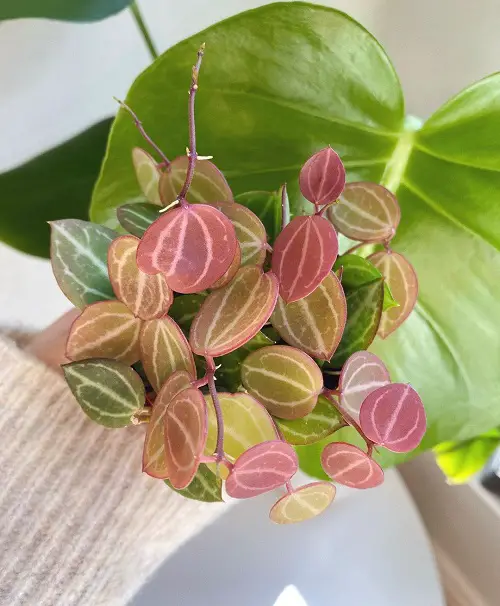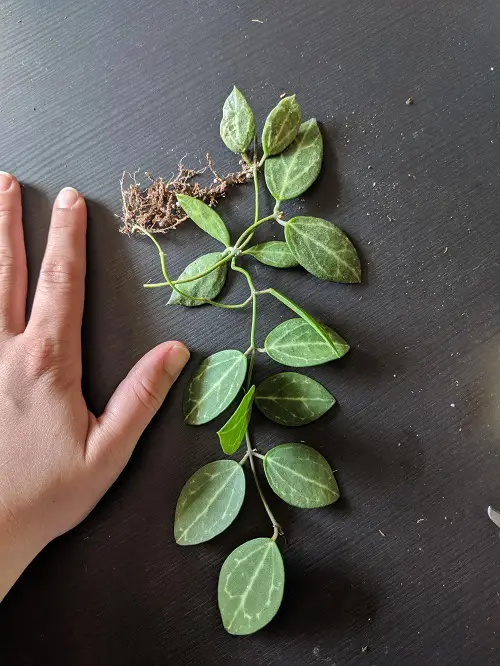Learn How to Grow Dischidia ovata, and include a stunning specimen in your houseplant collection that looks the part!

Also popular as Watermelon Dischidia, this plant can be an exotic houseplant to add to your collection. This tropical plant is closely related to the Hoyas and can provide an uncommon touch to your home. Here is an ultimate guide for you to learn all about How to Grow Dischidia opvata.
Botanical Name: Dischidia ovata
USDA Zones: 9-11
Check out some Unique Indoor Plants in Hanging Baskets Ideas here
Dischidia ovata Plant Information

Dischidia ovata derives its name from the word ‘Ovate’ mainly because of the beautiful egg-shaped or ovate leaves. This stunning trailing plant looks similar to the pattern of a watermelon rind and is also called the Watermelon Dischidia.
There are more than 100 Dischidia species, and these epiphytic plants are commonly found in tropical places in Taiwan, China, and India. Dischidia species love to grow on tree branches. They produce roots along the nodes to absorb water and necessary nutrients.
It is an easy-to-grow houseplant and looks perfect in hanging baskets or containers near a sunny window.
Learn about Growing Nasturtiums in hanging baskets here
Propagating Dischidia ovata

You can propagate Dischidia ovata easily by using stem cuttings.
- Cut 4-6 inches-long stems with nodes using clean, sharp knives or shears.
- Let the cut ends callous over for 6-10 hours before you plant them. Dip the ends in a rooting hormone.
- Plant the cuttings in moist sphagnum moss. Then, place the pot in a spot safe from wind and direct light.
- Keep the growing medium moist and provide indirect sunlight for 4-6 hours daily.
- In 2-3 weeks, the cuttings will form new roots.
Get the Best Tips for Growing Bigger and Fuller Petunias here
Requirements for Growing Dischidia ovata

Sunlight
Dischidia ovata can work best in a variety of sunlight conditions but prefers dappled light. It is best to place the plant near an East or North-facing window where it can receive the morning sunlight – this will help its leaves to grow bigger and get that stunning red-maroon hue.
Soil
Dischidia ovata thrives in an airy, light, well-draining, rich medium. You can grow it in shredded bark, orchid potting mix, coco coir, or a mixture of all these three.
Learn How to Change Your Soil pH here
Water
Keep the medium evenly moist at all times but not soggy. The best method to follow is to mist the growing medium using a spray bottle when it feels a little dry to the touch.
Temperature and Humidity
Dischidia ovata prefers humid conditions to thrive best and does not like cold temperatures. This tropical plant can grow well in any average household humidity and loves a temperature range of 40-80°F or 4-27°C.
Install a humidifier or a pebble tray if your indoor air is dry. You can even place the plant in your bathroom or kitchen if the other conditions are suitable.
Here are some great plants to take selfies with
Dischidia ovata Care

Fertilizer
Dischidia ovata is a slow grower, so you don’t need to worry much about feeding it. To boost the growth and color of the leaves, you can feed the plant with a balanced liquid fertilizer, diluted to 1/2 of its strength, once in 4-6 weeks.
Learn How To Make Bone Meal Fertilizer At Home here
Pruning
Dischidia ovata needs no pruning either. However, keep it in the desired shape by giving it a nice cut whenever required. Also, snip away the dead leaves from time to time.
Pests and Disease
This houseplant can fall prey to any common pests like mealybugs, spider mites, aphids, and fungus gnats. Use insecticidal soap to get rid of them.
Avoid overwatering or soggy soil to prevent root rot.


